Deciding on a career path can feel overwhelming, but with clear objectives, solid self-assessment, and a healthy trust of your gut instincts, you can do this thing!
Take our skills inventory assessment! Find out which important skills you already have; need to build; and want to use in your next job.
Taking Your Skills Inventory: Self-Assessment Time
By Dan Hahn and edited by Jelena Grove, Dan Hahn, M.S., and Suzie Sherman
Not sure what your next career move is? Schedule a call and let’s come up with a plan

Most people who find themselves in career transition have lost interest in something they once loved, decided their career values have shifted, were never truly engaged with their work in the first place, or never settled on one thing long enough to make it a career.
You were probably asked as a young person what you want to “major” in. It’s funny that not many of us had the guidance to attend more to the things we’re good at, or that we actually enjoy doing. Would we like to actually do the work which stems from our “major”? Would we like to do that work every day, long term?
Many times, that’s a straight-up, nope!
What if we were asked to plan our perfect week in the workplace. How many times in your career did you have the opportunity to plan your ideal week?
With most jobs, we’re provided a job description and simply asked to manage our tasks, but rarely are we allowed to choose the skills we would rather employ, much less choose a career path that aligns with our current skills.
Even if we were able to, most of us couldn’t say what we’re actually good at––or even what we like doing––even though we’ve been working for years.
On this page, you can take a detailed inventory of your skills. You’ll get insight into which ones you like using, which ones you’re good at, and consider what jobs you should be looking for that will allow you to actually use them!
Home → Helpful Articles → Career Exploration → Taking Your Skills Inventory: Self-Assessment Time
We’ve got lots of articles to help you to navigate your career exploration. Here are just a few we think you’ll find helpful:
- Your Career Exploration Brainstorm: Deepen your Search!
- How to Decide on a Career Path
- Your Career Values Assessment
- The 6 Best Career Exploration Websites to Narrow Down your Job Search
- Getting Clear on Your Career Path: Discerning Your Interests and Passions
If you’re feeling stuck trying to identify your career path, get in touch, and we’ll tailor an exploration to match your skills, passions, and financial needs.
How To Do This Exercise
Step 1: Print This Page!
While you’re at it, grab a pen and a yellow, blue, and orange highlighter. We’ll explain why below. If you’re on a phone, just browse through the long list of skills below. Reach out to us over the phone and we’ll help you get the clarity you need about how to use your motivated skills in your job or career search.
Step 2: Rank Your Skills by How Much You Enjoy Using Them.
To rank your skills, input the corresponding letter from the skill category (see the key below) under columns 1, 2, 3 or 4 for each skill in the table.
KEY:
1 (very satisfying) — skills you would enjoy using 50% of your time or more
2 (moderately satisfying) — skills you would like to use 25 to 50% of your time
3 (somewhat satisfying) — skills you would like to use 10 to 25% of your time
4 (not at all satisfying) — skills you never want to use again
C — communication skills
S — social skills
LM — leadership/management skills
CT — creative thinking skills
P — physical skills
CEA — creative and expressive arts
A — analytical skills
For example, if “explain” (from the communication category) is a skill you think you’d like to spend 50% of your time doing, you’d place a “C” in the “1” column for that skill. If you’d like to “influence/persuade” people 25 to 50% of the time, then you’d place a “C” under the “2” column.
Alright, now you try!
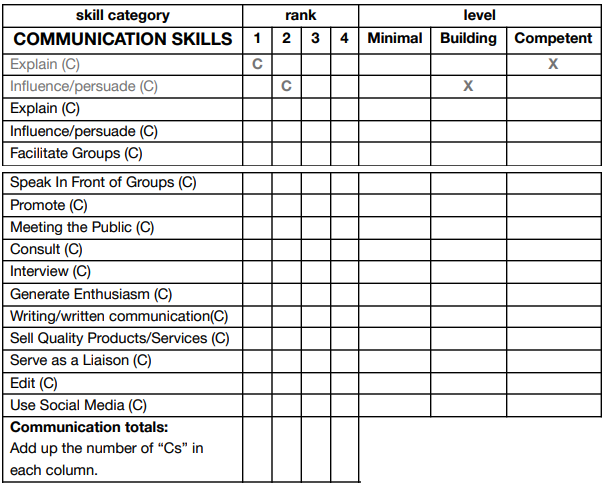
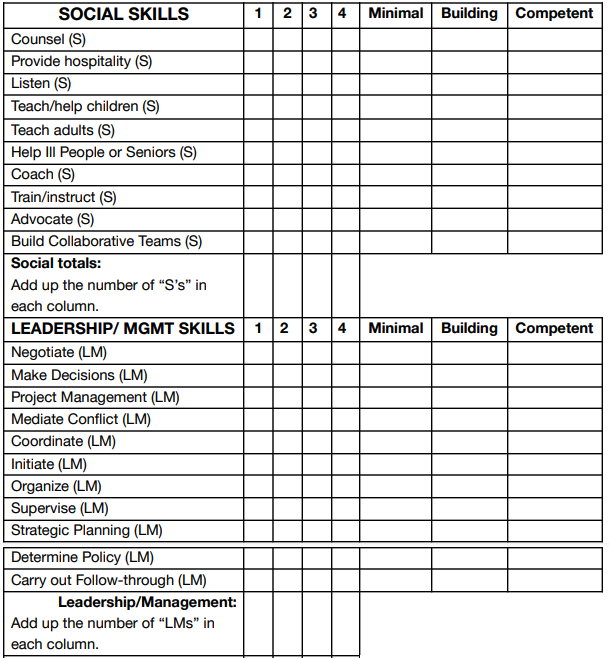
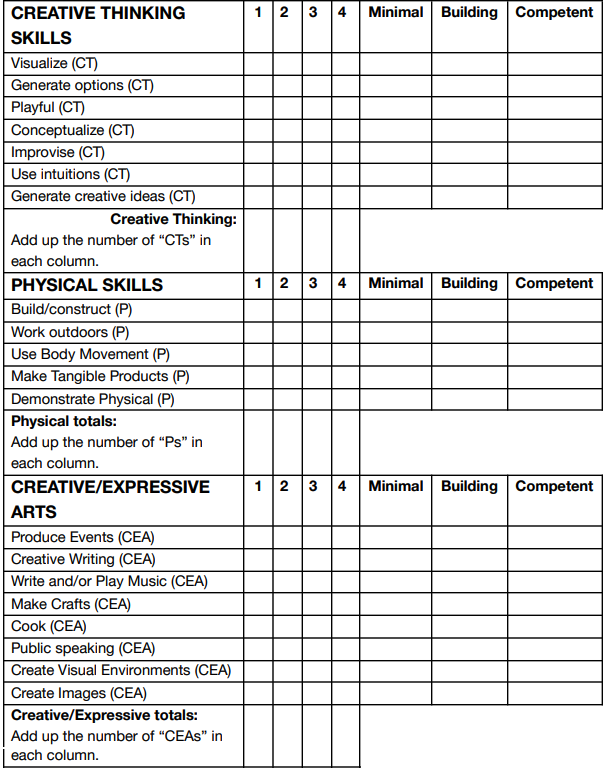
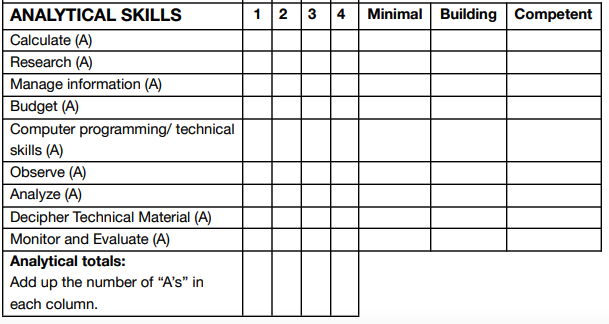
Step 3: Sort Your Totals According to Their Rank
Next, transfer the total number for each skill category in the tables below, according to each rank they fall under.
For instance, if your analytical skills looked like this:
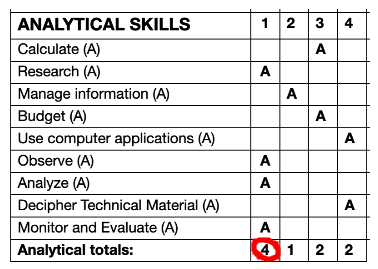
you would put a 4 in the A box in the 1 –– Very Satisfying table.
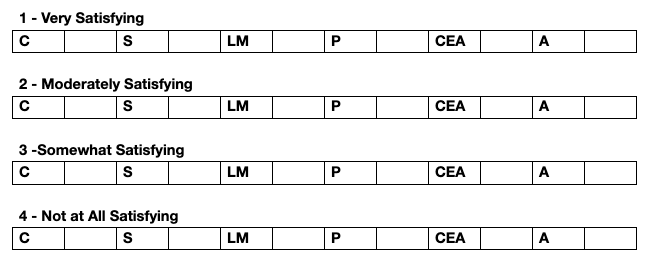
Because there are different numbers of skills in each category, you’re not necessarily comparing each skill here. It’s more telling to compare each rank (Very Satisfying, Moderately Satisfying, etc.) within each category. For instance, if you have a higher number of leadership skills that are ranked 1 compared to those that are ranked 2, 3 or 4, that’s worth paying attention to.
Step 4: Go Back and Rate Your Skill Level (Competence) for Each Skill
Rate your competence with each skill by placing an “X” in the adjacent cell under “Minimal,” “Building,” or “Competent.” Get a yellow, blue and orange highlighter. Mark the “Minimal” skills you ranked 1, 2 or 3 in yellow, the “Building” skills in blue, and the “Competent” skills in orange.
Pay attention to which Skill Categories interest you the most, then tune into which among those categories have higher instances of yellow and blue. These will indicate skills gaps that you should continue to develop. If you see a lot of orange in your high-interest categories that is definitely good news… but there is always room for improvement.
Step 5: Reflect on the Insights You Gained from This Exercise
Grab a sheet of paper and write down what you noticed during this exercise. When you’re done, file your paper in your career search binder for future reference.
Step 6: Assess Your Most Satisfying Skills
Use the form below to reflect on the skills you find “Very Satisfying” (the ones you ranked with a 1). This exercise will help you explore their meaning to you as well as clarify your top choices for jobs that require their use. In addition, you will gain insight into why you enjoyed and/or were recognized for these skills. Finally, this exercise will help develop your ability to present these skills with confidence when networking.
Instructions
First, print the form below (save image).
Then, for each of your “Very Satisfying” skills, think of a time you used that skill successfully and write down what you can remember about it. Did you receive positive feedback? Why was using this skill rewarding? For example:
- Speak in front of groups. I explained how the new recycling program would work to small groups of skeptical business owners. They commented on how clear I was about the benefits, and they liked my diagrams and humor.
- Use computer applications. I created a new database for a youth agency to track intakes, services and outcomes. I really enjoyed interviewing both clients and staff, and then analyzing their needs. It excites me to know that the system is still being used for grant applications.
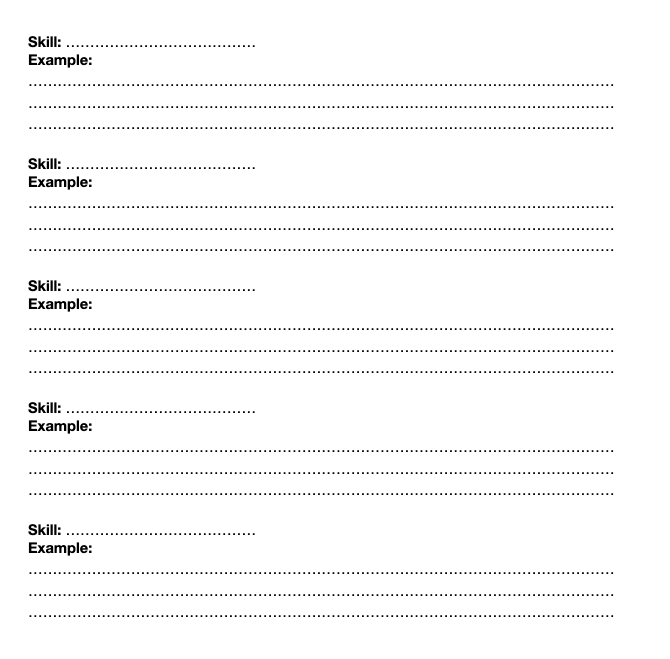
Explore Deeper
Now that you have an idea of the skills you like to use and your level of competence in them, you can explore each one further using an online tool called the O*NET Database. It can give you a sense of how the competencies you possess (and new skills you want to acquire) can help you transition to a fulfilling career that matches your interests and sense of purpose, while taking your abilities into account.
Final Thoughts
Career development is a process that takes time, effort, and patience; taking a skills assessment like this one may not be your first choice for the way you’d like to spend your free time. But just ask our clients –– it’s worth it.
Making a list of skills and competencies can be a huge help in your career decision making process. Knowing what you’re good at is extremely motivating, and knowing what you need to improve in can help you build your skill set (with education, training, mentoring, and certifications) to fit the needs of the jobs you want.
It’s worth noting that there are several hard and soft skills and hard skills we don’t list here. Things like critical thinking, adaptability, interpersonal skills, time management, workforce optimization, teamwork, computer programming, human resources, succession planning, leadership development, talent management (the list goes on) are all worth your attention and deeper reflection.
Key takeaways
- It takes time and effort to identify the skills you actually like using –– even if you’ve been in the workforce for a long time
- Use online tools like the O*NET OnLine database to dig deep into the skills you have and identify the jobs that require them
- You don’t need to focus on being highly skilled in every single category (or even multiple categories) unless you’re on an executive or leadership career track
- Pay attention to the skills you marked as yellow or blue, as these indicate areas you want to develop in
- Once you hone in on the skills you like and want to use, you can incorporate them into your conversations during networking
Related articles you might be interested in:
Getting Clear on Your Career Path: Discerning Your Interests and Passions
Decide whether you should pursue a practical career or a passionate calling with our career interest assessment.
What Does Your MBTI Personality Type Mean for Your Career?
Find out your MBTI personality type with our Myers-Briggs career assessment, and learn what it means (or doesn’t mean) about your career preferences!
Your Career Values Assessment
So often, our careers seem to be at odds with our core values. This career values exercise gives you permission to think outside the cubicle and find work you love!





